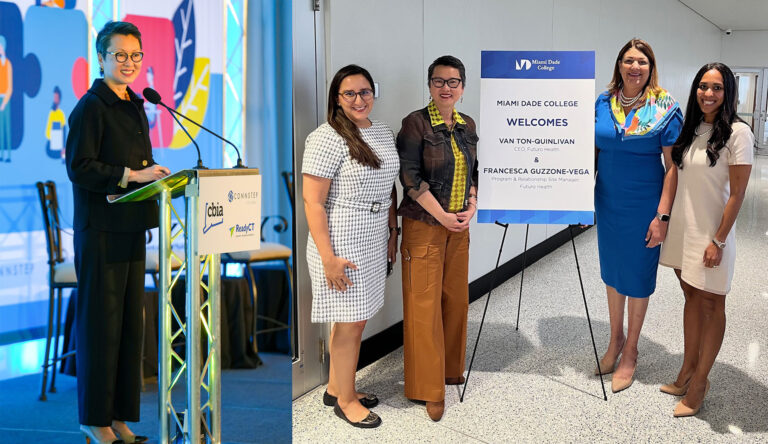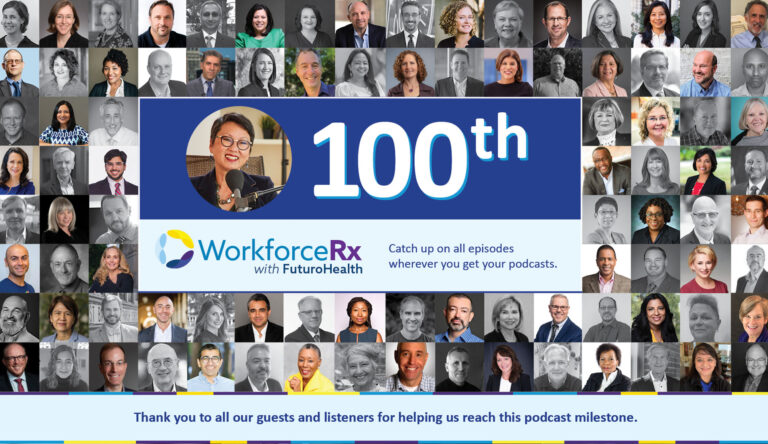Last December, the Washington Post called our current labor crisis “the most unusual job market in modern American history,” citing COVID, the recession, and the “big quit.” But one of the most pernicious causes of the crisis (and one that predated the events of 2020) is a massive mismatch between employers’ needs and job candidates’ skills. At the time of the article, 8.4 million Americans were unemployed, yet industry struggled to fill 10 million job openings.
To meet this challenge, “We need our nation to have all our engines revving to connect people with the right skills for the right jobs,” says Van Ton-Quinlivan, CEO of Futuro Health.
Van, a veteran of the workforce development field, has more than a few ideas on how to transform the crisis into opportunity. And her ideas are gaining traction: Van’s new book, “WorkforceRx: Agile and Inclusive Strategies for Employers, Educators and Workers in Unsettled Times,” is rocketing up the Amazon bestseller and hot new release lists.
To discuss her “prescription” — specifically chapters five and six — Van invited a panel of colleagues in business and education to the WorkforceRx with Futuro Health podcast. Each guest shared the insights, stories, and strategies from Van’s book that resonated with them most.
Read on for these experts’ thoughts on collaboration, innovation, and reimagining the educational system to better fit our reality in 2022.
The Panelists
Chauncy Lennon, Ph.D., Vice President for Learning and Work, Lumina Foundation
Earl Buford, Chief Executive Officer, Council on Adult Experiential Learning
Rock Pfotenhauer, Chair, Bay Area Community College Consortium
Amrit Ahluwalia, Editor in Chief, The EvoLLution
Jim Caldwell, Chief Executive Officer, Workforce Incubator
Rajinder Gill, CEO and Co-Founder, Essential Skills Program
Steve Wright, ICT Statewide Director, California Community Colleges

‘Boring’ can be beneficial
Chauncy Lennon, Lumina Foundation’s Vice President for Learning and Work, believes that in the wake of COVID, Van’s prescription for skills-based training is even more critical for our country to “‘build back better,’ as the Biden administration would put it,” he says.
Van’s book reminds us why “we’ve got to find better language to help explain to a wider audience why investments and policies around building skills benefits not just individuals or businesses and industries, but all of us,” Chauncy adds.
Although the community college system faces challenges and there are many areas that need to be improved, we don’t need to reinvent the wheel. If we want to make an impact at scale, we need to start with the existing system.
“Van uses the phrase, ‘money, metrics, data,’ and that’s exactly right,” says Chauncy. “We should think about policies that allow the system to be more agile … We’ve got a system that was designed for a different era. We’ve got to redesign it.”

Embrace ‘intentional collisions’
Earl Buford, President of the Council for Adult and Experiential Learning (CAEL), thinks Van set up the model for an effective “echo chamber” with her “three-legged stool” analogy: the idea that a community, employers, and training/education providers need to work together for lasting change.
For these three “legs” to collaborate and produce a new generation of skilled workers, we need articulation, says Earl.
Training and education providers must understand exactly what employers are looking for, while employers should ensure that talent development, attraction, and retention efforts are spelled out clearly. The joint effort ensures members of the community are confident their educational pursuits will support their economic goals.
Earl calls three-legged-stool-style collaborations “intentional collisions.”
“When you’re intentionally making these things connect, and there’s an articulated purpose, scale is approachable,” he says.

‘The speed of need’ is the pace of today
Bay Area Community College Consortium Chair Rock Ppfotenhauer agrees with Chauncy: We lack the necessary vocabulary to communicate these ideas about education and the workforce with the general public.
As someone who has been working in the community college and workforce development space for a long time, Rock appreciates Van’s efforts to address the need by reconfiguring our resources “in ways that will enable us to increasingly move — to use a phrase from the book that I really like — at the ‘speed of need,’” he says.
The COVID-19 pandemic has “made that need so much more apparent,” Rock adds. “The chasm separating the populations we serve, and the work that pays livable wages, requires us to substantially reconfigure how we deliver education, and it requires us to form partnerships with other systems. We can’t and shouldn’t be bridging this chasm alone.”

Grads need skills and tools to leverage them
“How do we connect our post-secondary ecosystem and programming to the needs of folks on the ground who are looking for pathways into careers?” asks Amrit Ahluwalia, the editor of The EvoLLLution, an online newspaper focused on non-traditional higher education.
Amrit says the average liberal arts degree program “is workforce training for academics. It’s not necessarily focusing on rich skill set development.”
Among those skills? The ability to articulate, think critically, communicate effectively, and collaborate across groups. Those are the skills that employers seek — “and those are the skills we expect students to have upon completion. But we don’t necessarily give them the tools to recognize that they have those skills, or to understand how to leverage them.”

‘Stackable credentials’ can build the talent pipeline
Workforce Incubator CEO Jim Caldwell’s biggest takeaway focused on the idea of “talent pipeline development,” which he thinks has meaning for both education and industry.
“Industry certainly needs to build talent pipelines somehow, and educators are a primary means for helping do that,” he says.
Simple changes can have huge impacts for businesses, students, educators, and industry alike, Jim explains.
He thinks shifting focus towards talent pipeline development is a compelling way to think about workforce development.
Jim particularly appreciated Van’s discussion of the employer-faculty ecosystem — “a rich exchange of ideas, beyond the normal advisory groups that a lot of faculty have as part of their curriculum.”
This helps with funneling jobs into the regional labor market by collaborating with multiple colleges and executive level employers. Then, schools can align their curricula with the needs of industry and “develop a system of stackable credentials along a much broader career map.”

Systemwide and scalable
Steve Wright, ICT Statewide Director, California Community Colleges, remembers meeting Van when he was hosting seminars for small businesses online — “maybe twelve businesses at a time, once a month,” Steve recalls.
Van told him: “Steve, that does not scale. You need to think systemwide.”
At the time, he didn’t understand Van’s advice about scalability (which she also addresses in the book). But when he took his experience at Verizon, GTE, and a number of tech companies into account, he realized: “I’ve seen lots of midlife people go through certifications. I saw the community college playing an important role in helping those kinds of skills acquisitions.”
Steve and his team interviewed placement agencies like Manpower and certification market research teams. He joined the IT certification council. He paid for a survey of 400 small businesses to discover the skills they needed, hosted focus groups with industry associations, and interviewed many corporate hiring executives.
The result? A much better understanding about which courses and training programs really matter. The business leaders endorsed a number of pathways and later helped hire along those pathways, which aligned with industry certifications.
Replicating this kind of inquiry and formalizing career pathways across the country won’t be easy, though.
“There’s something in the community college system that resists scale,” says Steve. “Perhaps what we really need to achieve beyond scale is consensus, because inevitably, what happened to these pathways is they got customized for this college or that college — so it was all integrated into what they did. I think the enduring concept of this scalability seems to be that all educational platforms, inside or outside the community colleges, can play part of a certification-based pathway … The question is, are we ready for it?”

Scale begins at the grassroots level
Rajinder Gill, CEO and Co-Founder of California’s Essential Skills Program, says “WorkforceRx”” makes important points about soft skills and achieving scale.
“People do talk about scale a lot, but you need a guidebook for how you’re going to do that.”
She thinks what Van calls an “ecosystem of the willing” is key, because it gives us the opportunity to think of one another as collaborators. That kind of partnership creates a “natural equity check to everything you do,” she says.
That’s why feedback is important — and why some of it is absolutely crucial.
“When you really mean it, your blind spots go away,” she argues.
In the California Community College system, Rajinder encounters learners on a spectrum, ranging from high school students taking early college classes to people recently released from incarceration who want to rejoin the workforce. Collaboration is the only way to achieve scale in that scenario.
“Scale can be achieved in a grassroots manner, so it doesn’t feel top down,” Rajinder explains. “It’s not a hierarchy. It’s something built together.”
She also thinks that focusing on skills, particularly interpersonal (“soft”) skills, builds students’ confidence and employability.



